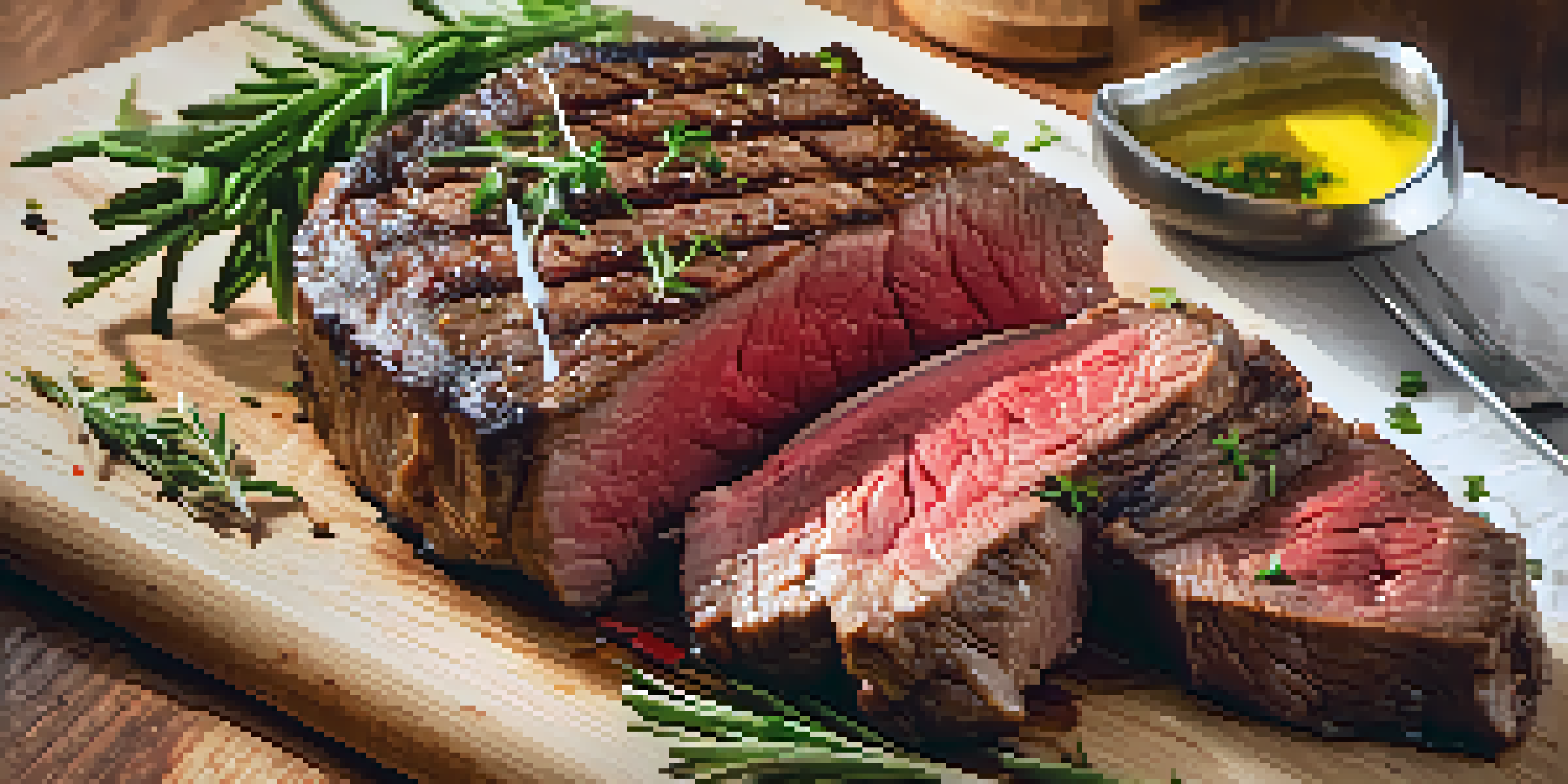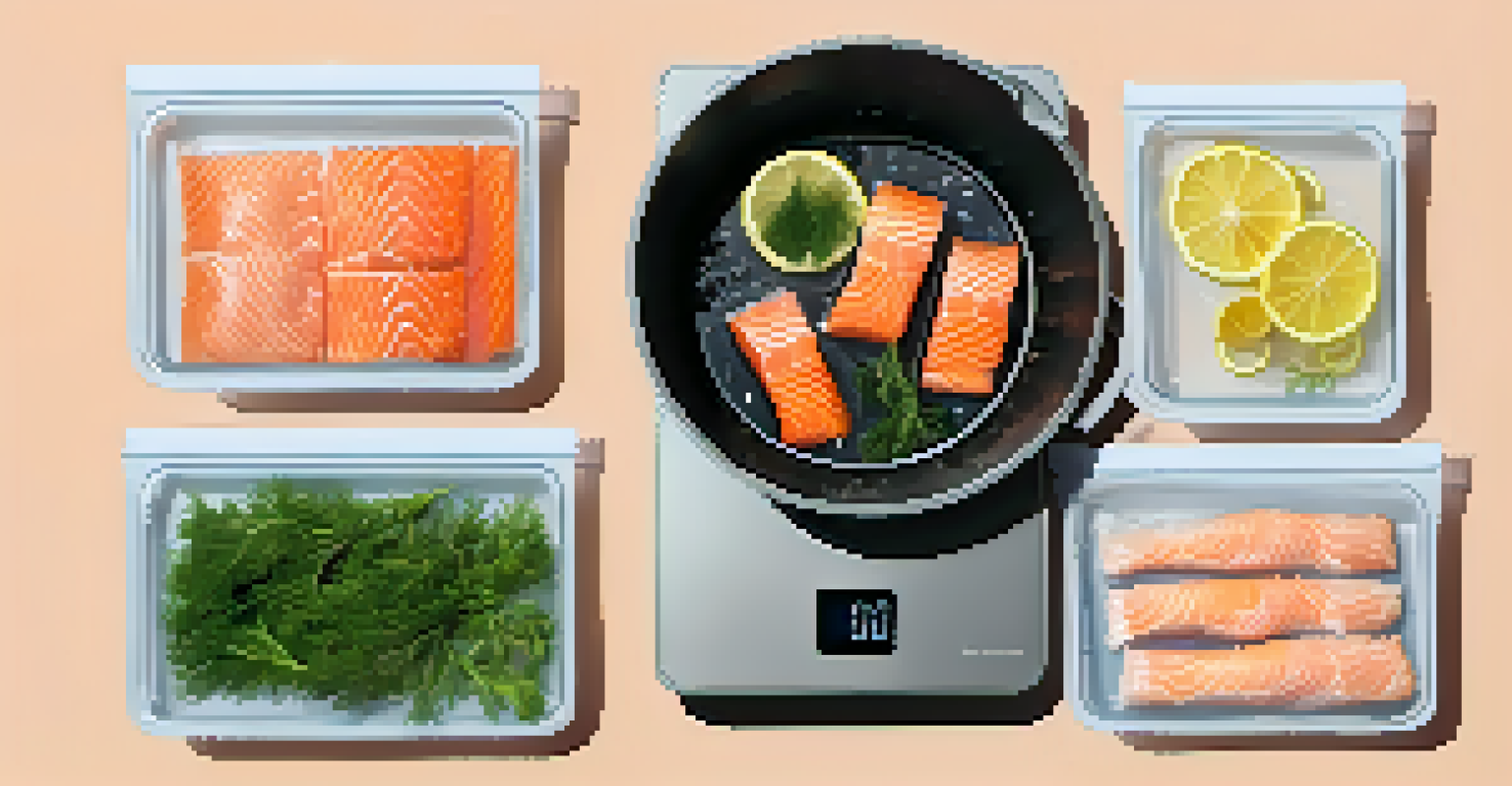Culinary Techniques: Mastering the Art of Sous Vide Cooking

What is Sous Vide Cooking and Why It Matters
Sous vide, which means 'under vacuum' in French, is a cooking method that involves sealing food in airtight bags and cooking it to a precise temperature in a water bath. This technique allows for unparalleled control over the cooking process, ensuring that food is cooked evenly and retains its moisture and flavor. Imagine cooking a steak to the exact doneness you prefer without the risk of overcooking it.
Cooking is like love. It should be entered into with abandon or not at all.
One of the key benefits of sous vide cooking is its ability to enhance the natural flavors of the ingredients. By cooking food at lower temperatures for longer periods, you not only achieve a tender texture but also intensify the taste. This method is perfect for delicate proteins like fish, which can easily dry out using traditional cooking techniques.
Moreover, sous vide cooking is incredibly versatile and can be used for a variety of dishes, from meats and vegetables to desserts. It opens up a world of culinary possibilities, allowing home cooks to experiment like professionals. With a sous vide setup, even novice cooks can produce restaurant-quality meals.
Essential Equipment for Sous Vide Cooking
To get started with sous vide cooking, you'll need a few essential pieces of equipment. The most crucial item is a sous vide immersion circulator, which heats the water and circulates it to maintain a consistent temperature. There are various models available, ranging from budget-friendly to high-end, so you can choose one that fits your cooking style.

In addition to the immersion circulator, you'll need vacuum-sealable bags or containers to hold your food while it's cooking. Vacuum sealers can be a great investment, but you can also use zip-top bags with the water displacement method to remove air. This ensures that the food is in contact with the water for optimal cooking.
Sous Vide Enhances Flavor
Cooking food at precise temperatures intensifies natural flavors and maintains moisture, resulting in delicious, tender dishes.
Finally, a reliable thermometer is helpful to double-check the water temperature, ensuring you achieve the desired results. Once you have your equipment ready, you'll be well on your way to mastering sous vide cooking!
Preparing Ingredients for Sous Vide Cooking
Preparing your ingredients is a vital step in the sous vide process. Start by selecting high-quality ingredients, as the cooking method will amplify their natural flavors. For meats, look for cuts that are well-marbled, as the fat will render beautifully during cooking, enhancing both taste and tenderness.
The only real stumbling block is fear of failure. In cooking, you’ve got to have a what-the-hell attitude.
Once you've chosen your ingredients, seasoning is key. You can add herbs, spices, and even marinades directly into the vacuum-sealed bag with the food. This allows the flavors to infuse during cooking, creating a deliciously seasoned dish. Think of it like a flavor bath for your ingredients!
Lastly, ensure that your food is properly sealed to avoid any water infiltration during cooking. A tight seal not only ensures even cooking but also keeps your ingredients safe. With everything prepped, you're ready to dive into the sous vide cooking process.
The Sous Vide Cooking Process: Step-by-Step
The sous vide cooking process is straightforward, making it accessible even for beginners. Start by filling a large pot or container with water and attaching your immersion circulator. Set the desired temperature based on the type of food you're cooking; for example, a steak might be set at 129°F for medium-rare.
Next, place your vacuum-sealed bag with the food into the water bath, ensuring it's fully submerged. It's important to keep the water circulating to maintain an even temperature throughout the cooking process. Depending on the size and type of food, cooking times can vary, so be sure to check recommended guidelines.
Essential Gear for Success
Key equipment includes a sous vide immersion circulator and vacuum-sealable bags, which are crucial for achieving optimal cooking results.
Once the cooking time is complete, remove the bag from the water bath. For proteins, a quick sear on a hot skillet or grill can create a beautifully caramelized crust, enhancing both texture and flavor. The result is perfectly cooked food that is juicy and bursting with flavor.
Benefits of Sous Vide Cooking
Sous vide cooking offers numerous benefits that elevate the home cooking experience. One of the most significant advantages is precision; cooking at specific temperatures ensures that your food reaches the perfect doneness every time. This eliminates the guesswork often associated with traditional cooking methods.
Another benefit is the ability to prepare meals in advance. Since sous vide cooking allows for long cooking times without overcooking, you can set your meal to cook while you attend to other tasks. This convenience is especially helpful for busy weeknights or when hosting dinner parties.
Additionally, the sous vide method enhances food safety. Cooking food to a precise temperature and holding it there ensures that harmful bacteria are eliminated. This makes sous vide a reliable choice for cooking proteins, ensuring they are both safe and delicious.
Common Mistakes to Avoid in Sous Vide Cooking
While sous vide cooking is relatively straightforward, there are a few common mistakes that can affect your results. One frequent error is not sealing the bags properly, which can lead to water entering the bags and ruining the food. Always ensure you’ve removed as much air as possible before cooking.
Another mistake is cooking at the wrong temperature. It's crucial to understand the right temperatures for different types of food. For example, cooking chicken at lower temperatures can result in a tender, juicy texture, but it must be held long enough to ensure safety. Research and follow guidelines to achieve the best results.
Avoid Common Cooking Mistakes
Proper sealing, temperature control, and finishing techniques are essential to avoid pitfalls and ensure perfectly cooked meals.
Lastly, don’t forget about finishing techniques! Some people skip the final searing step, which can result in a less appealing dish. A quick sear can add that sought-after crust and additional flavor, so don’t miss this crucial step in the sous vide process.
Experimenting with Flavor Combinations in Sous Vide
One of the most exciting aspects of sous vide cooking is the opportunity to experiment with flavor combinations. Since sous vide allows for precise temperature control, you can play with various herbs, spices, and marinades to find your perfect match. For example, consider pairing lemon and dill with salmon for a fresh, vibrant dish.
You can also infuse oils or butter with herbs before adding them to your vacuum-sealed bags. This technique not only enhances the flavors but also adds a gourmet touch to your home-cooked meals. Imagine the rich taste of garlic-infused oil drenching your perfectly cooked vegetables!

Don’t hesitate to get creative! Sous vide cooking is forgiving, so feel free to try new things. As you gain confidence, you might discover unique flavor profiles that elevate your dishes to a whole new level.